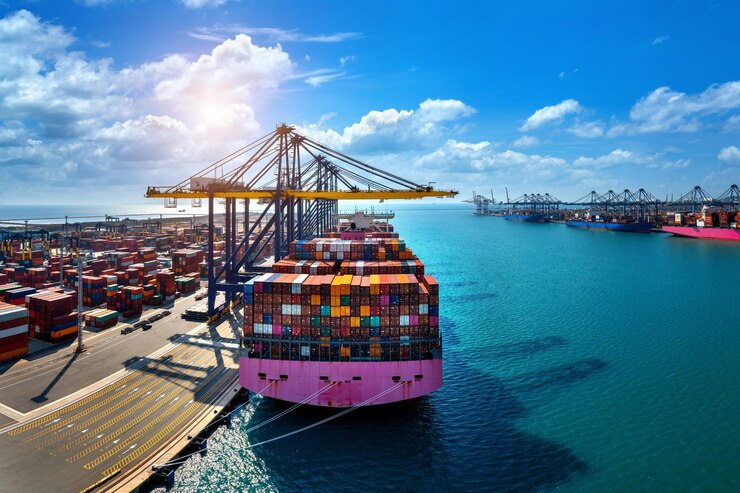The global trade network is an intricate web of supply chains, routes, and logistical coordination. At the heart of this system lies sea freight—an essential mode of transportation responsible for moving billions of tons of goods across the world’s oceans every year. From small startups expanding internationally to established companies managing global supply chains, sea freight continues to be the backbone of international trade.
But what exactly is sea freight, and why has it maintained its dominance in global logistics? Let’s dive into the ocean of opportunities it provides while also exploring its nuances.
What Is Sea Freight?
Sea freight, also known as ocean freight, refers to the transportation of goods by ship across seas and oceans. Unlike air freight or road transport, sea freight is ideal for moving large volumes of goods cost-effectively over long distances. Whether it’s raw materials like oil and minerals or finished products such as electronics and furniture, ships have been the go-to method for bulk transportation for centuries.
One of the primary reasons businesses opt for sea freight is its unmatched capacity. Cargo ships today are marvels of engineering, capable of carrying thousands of containers filled with goods. This capacity makes it not only cost-efficient but also environmentally friendly, given the reduced carbon footprint per unit of cargo compared to other forms of transportation.
Key Benefits of Sea Freight
1. Cost-Effectiveness
Sea freight stands out for its affordability. Shipping large quantities of goods by sea is significantly cheaper than other forms of transportation like air freight. Companies looking to optimize their logistics costs often turn to ocean freight, especially when time sensitivity is not a primary concern.
2. Global Reach
The world’s oceans connect virtually every continent, allowing sea freight to reach destinations far and wide. Whether you’re shipping goods from Asia to Europe or from North America to Africa, ocean freight ensures reliable connectivity across international markets.
3. Versatility in Cargo Handling
From small packages to oversized machinery, sea freight accommodates a wide variety of cargo types. Specialized containers can handle temperature-sensitive goods, liquid cargo, and even hazardous materials. This adaptability makes it a preferred choice for industries ranging from agriculture to manufacturing.
4. Eco-Friendliness
As the logistics industry strives for sustainability, sea freight has emerged as a greener alternative. Ships emit less CO2 per ton of cargo compared to airplanes or trucks, making it an environmentally conscious choice for businesses prioritizing sustainability.
Challenges to Consider
While sea freight offers numerous advantages, it’s not without its challenges. Understanding these can help businesses plan better and make informed decisions.
- Longer Transit Times: Unlike air freight, sea freight is not ideal for time-sensitive shipments. The transit times are significantly longer, sometimes taking weeks to reach a destination.
- Customs and Documentation: Shipping goods internationally involves navigating complex customs regulations and ensuring proper documentation. Delays in paperwork can lead to increased transit times and additional costs.
- Weather Dependency: While modern ships are equipped to handle most weather conditions, severe storms or natural disasters can disrupt shipping schedules.
Sea Freight vs. Other Modes of Transport
When choosing between transportation methods, businesses must weigh several factors, including cost, speed, and environmental impact.
- Air Freight: Faster but far more expensive, air freight is often used for high-value, time-sensitive goods like electronics or pharmaceuticals.
- Road Freight: Ideal for shorter distances and inland transportation, but it lacks the capacity and efficiency of sea freight for long-haul international shipments.
- Rail Freight: A middle-ground option that’s faster than sea freight but not as cost-effective for large volumes.
Despite the alternatives, sea freight remains the go-to option for businesses prioritizing cost and capacity over speed.
How Sea Freight Powers Global Trade
Sea freight is not just a mode of transportation—it’s a lifeline for global trade. According to the United Nations Conference on Trade and Development (UNCTAD), over 80% of the world’s traded goods by volume are transported by sea.
This staggering figure highlights the importance of shipping lanes and ports in facilitating international commerce. Major ports like Shanghai, Singapore, and Rotterdam act as hubs, connecting exporters and importers across continents. These ports handle everything from containerized goods to bulk commodities, making them critical nodes in the global supply chain.
Moreover, advancements in technology, such as automated ports and smart shipping solutions, are making sea freight even more efficient. Real-time tracking, improved navigation systems, and better fuel efficiency are just a few examples of how the industry is evolving.
The Role of Sea Freight in a Sustainable Future
As environmental concerns take center stage, the logistics industry is under pressure to reduce its carbon footprint. Sea freight is already a step ahead, thanks to its energy efficiency. However, there’s still room for improvement.
Innovations like cleaner fuels, electric ships, and optimized shipping routes are being explored to make ocean freight even more sustainable. Companies are also adopting practices like slow steaming, which involves reducing ship speeds to cut fuel consumption and emissions.
Choosing the Right Partner for Your Sea Freight Needs
Whether you’re a small business venturing into international markets or a large corporation managing a complex supply chain, finding the right logistics partner is crucial. Look for a provider with a proven track record in sea freight, a global network, and a strong commitment to sustainability.
Working with experienced professionals ensures that your cargo reaches its destination safely and on time, while also navigating the complexities of customs and documentation.
Conclusion
Sea freight is more than just a means of transportation; it’s a vital component of global trade, enabling businesses to connect with markets worldwide. Its cost-effectiveness, versatility, and sustainability make it an invaluable tool for companies looking to scale internationally.
As technology and sustainability continue to reshape the industry, sea freight will remain a cornerstone of global logistics. Whether you’re shipping a single container or managing a fleet of goods, the ocean is a reliable partner in your journey toward global success.
If you’re considering sea freight for your logistics needs, take the time to explore your options and understand the nuances of this powerful transportation method. After all, the world’s oceans hold endless possibilities for businesses ready to make waves in the international market.










 /home/u448362301/domains/theexpotab.com/public_html/wp-content/themes/foxiz/templates/popup.php on line 167
/home/u448362301/domains/theexpotab.com/public_html/wp-content/themes/foxiz/templates/popup.php on line 167